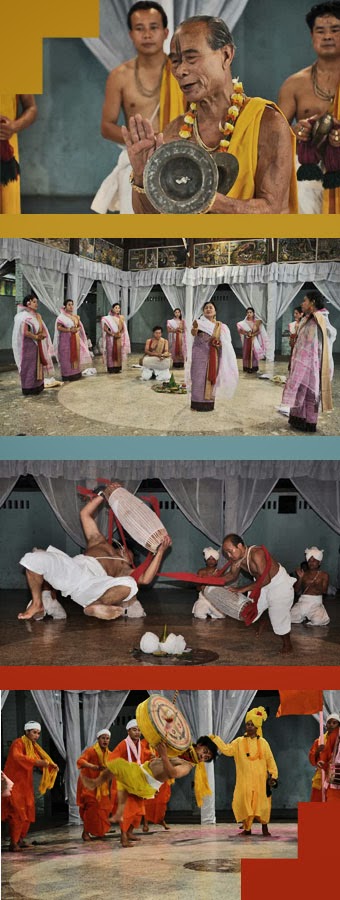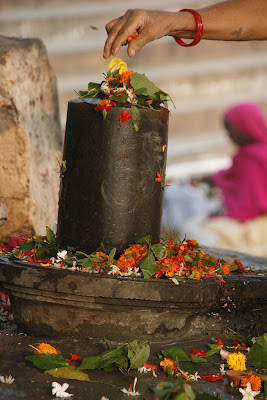Sankirtan Blues: Cultural Heritage or Museum Artefact
Sankirtan is ready to go places, literally, with recognition from the United Nations Educational, Scientific and Cultural Organization (UNESCO) as a cultural heritage. The acknowledgement suggests as well this art form should rather be kept away in a museum.
A credit for such a local cultural stuff on the global platform sounds so delightful with reasons galore. In the excitement, however, we miss might a few points why Sankirtan should rather be a museum artefact than a heritage —for an equal number of opposite reasons. No doubt, it is so close to the contemporary Manipuri culture but that’s a problem in the first place.  |
| SANKIRTAN STILLS Collaged for In Pursuit of Freedom Image from the Indira Gandhi National Centre for the Arts |
The news first. UNESCO is building peace in the minds of men and women, so it says on its website. It has the Intergovernmental Committee on the Convention for the Safeguarding of the Intangible Cultural Heritage, which meets once every year. Sankirtan is the sole entry from India to be included in the heritage list in 2013.
The Sankirtan Story
Sankirtan is, to quote T Raatan, ‘a unique and harmonious combination of masculine vigour and Vaishnavic humility.’ In his Encyclopaedia of North-east India: Arunachal Pradesh, Manipur, Mizoram, he mentions this ritual singing, drumming and dancing ‘can be divided into two aspects: the musical aspect and the cholom aspect … one is complimentary to the other. The cholom aspect may again be divided into two parts: pala-cholom and pung-cholom’. The first musical expression includes the singing-type Nat Sankirtan. It is a typical high-pitched, open-throated rendering.
What’s all the fuss about this cultural heritage? Culture and tradition make a society. The blend is so strong that it cements the ties between the people as much as it is liable to break the whole society into pieces. Sankirtan was developed when Hinduism started bulldozing the region with chants, Aryan arrogance and a remarkable future process of Indianisation. This had surfaced and developed between 16th and 18th centuries. No wonder, during this very long period, we have forgotten how a foreign belief and value system replaced the natives’ originality.
We suffer from split personality disorder. The armed conflict is the biggest syndrome. Then there are serious cases of symptoms such as sense of belonging nowhere and resentment towards the establishment—those which we may put off but it will be unwise to ignore completely. No one can deny the winds of revivalist thoughts that have been blowing for the past seven–eight decades in the province. Sankirtan would be no harm if we settle the identity question for good—but unfortunately it is not. What’s worse is our belief. Some of us even held the preconception that we have our roots in these so-called cultural stuffs. (Read ‘Western Sankirtan’ at Cinema Paradiso, http://kapilarambam.blogspot.in/2012/06/western-sankirtan-at-cinema-paradiso.html)
 |
| SOME RENOWNED SANKIRTAN BLUES MASTERS Collaged for In Pursuit of Freedom Top to bottom: Late Panditraj Atombapu Sharma, Late Guru H. Atomba , Late Guru Ningombam Lairenjao Image from Manipuri Nata Sankirtana |
Proponents argue that Sankirtan is intrinsically Manipuri just like the Ras Leela. An overt acculturation of many forms and styles from the indigenous martial arts and the like are incorporated in these art forms. This harmonious combination of masculine vigour and Vaishnavic humility brings along waves of Hindu thoughts. It will be too naïve to separate religion from politics. Off and on it, is sheer absurd to follow the mainland thoughts when there are blatant oppression and all we face are ignorance and arrogance from the ‘other’ people, who matter when we talk about a ‘nation’ or a ‘state’.
No man is an island and subsequently, this is why we should mingle as well as accept the change at the societal and individual level. Otherwise we are only as good as the hardheaded troglodytes. In a globalised world, defined by the dependent economies, it is even more imperative that we know the flow, and what’s in and what’s out. However, it would be completely suicidal if we follow the conventions blindly. Sad but true, we are more suicidal than flowing with the flow.
First, relatively, we are a small group of people. We are hardly three millions, but divide that by 33, which is the number of officially recognised ethnic groups. Second, we have neighbours where outsiders have outnumbered the natives. Tripura is the perfect example. Third, we have accepted the values and beliefs of others as our own—the first casualty is identity that aggravates the problem to no limit.
Death Duty
So where do Sankirtan fit in the scheme of things? History shows the natives grew as a martial race, and was developing deeper relationships with the neighbours, read the Southeast Asians. When Hinduism arrived, the fundamentalists howled those fervour and energy to use swords (thang), spears (ta) and shield (chungoi), locally known as the thang-ta aka huyen langlon, have been replaced by insidious kirtans or qortals—while we have been Aryanised despite the unlikely faces that we have evolved from. Imagine telling Hitler that we are also Aryans. There could have been no Nazism.
Alternatively, the kirtans led everyone, from the master rulers to the natives, to indulge in pleasure and orgy as are evident from the fun and frolic that are synonymous to dance and entertainment. And now Southeast Asia is cut-off, if not for the recent interests in redeveloping relations in the name of the Look East Policy. Meanwhile, the State Museum is the best place to visit if anyone wants to have a feel of the illicit relationship between the thang-ta and the kirtans; several pieces of the two entities are carefully curated in the same room.
Wouldn’t it be wrong to say that Sankirtan is a disgrace to huyen langlon, a disgrace to our existence? We know it still plays a major role in socio-religious activities, leave alone the recognition from UNESCO. However, we are not sure if this should really be a cultural heritage or a museum artefact. Some of us might be apprehensive that we will be culturally disrobed if we disown it, but the various legacies depict otherwise. For instance, only in the thang-ta genre, there are countless dance forms: ta-kousaba, thang leiteng haiba, chei khatpa, lhou sha, thang-ta-cheiraba, to name a few. It might seem out of place in ordinary rites and rituals where Sankirtan plays the conductor but the point is that there is no dearth of alternatives.
 |
| Thang-ta Image from Manipur Tourism |
For long, it was speculated that Sankirtan should be positioned along with the classical Manipuri dance, the ubiquitous Krishna-Radha break dance which is counted among the finest Indian dance forms. Now the time has arrived and as much as Ras Leela makes us Indian, the Sankirtan is going to accentuate the process at the cost of indigenous evolutionary narratives and histories. Methinks it is possible should we turn artificial Aryan cent per cent, and solve the issues of identity crisis for good—as the natives become a museum piece and the place a haven for anthropologists. It is possible considering the armed conflicts that have ripped apart the society. It is possible considering the informed decisions of the astute mainland policy makers.
...................................................................................................................
In the News
"The Sankirtana — ritual singing, drumming and dancing of Manipur — along with Bangladesh’s Jamdani weaving and traditional Japanese Washoku cooking methods was among 14 new entries added to UNESCO’s list of “intangible heritage” in need of being preserved.
The Intergovernmental Committee for the Safeguarding of Intangible Heritage, holding its 8th session until December 7 in the Azerbaijani capital Baku, last night, inscribed 14 elements on the Representative List of the Intangible Cultural Heritage of Humanity."
...................................................................................................................
Details
Manipur’s Sankirtana in UNESCO’s List of Intangible Heritage
For More Information
...................................................................................................................
- Manipuri Dance, http://www.darshanajhaveri.com/manipuridance.html
- Intangible Cultural Heritage — Sankirtan of Manipur, http://www.ignca.nic.in/ICH/ich_photos/ich00016/index.htm
- Manipuri from the Centre for Cultural Resources and Training, http://ccrtindia.gov.in/manipuri.php
- Manipuri Nata Sankirtana, http://manipuri-nata.com/tribute-guruji1.html
...................................................................................................................
‘Our civilization is an immense woven fabric in which very different elements are mixed… In such a fabric it is pointless searching for a thread that has remained pure, virgin and uninfluenced by other threads nearby.’
— JAMES JOYCE, 1907, ‘Ireland: Island of Saints and Sages’.







Comments
Post a Comment